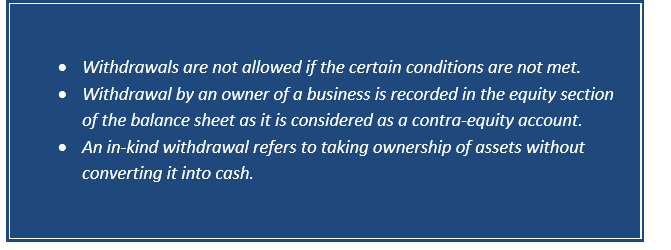What is Withdrawal?
A withdrawal refers to the act of taking out funds from bank accounts, pension plans, saving plans or any trust and it can occur over a period of time in variable, fixed or lump sum. Withdrawals are not allowed if the certain conditions are not met. In some cases, penalties are imposed if a clause in investment contract is broken such as early withdrawal, which affects the amount paid out, resulting in a smaller net payment. The individual retirement account and certificate of deposit impose withdrawal penalties if the contract is breached or withdrawal is made before the stipulated time.
However, if an owner withdraws money from the company for personal use, the transaction affects both owner’s equity and assets. Withdrawal by an owner of a business is recorded in the equity section of the balance sheet as it is considered as a contra-equity account. However, its balance is the opposite of a regular equity account. It is because the withdrawal account has a debit balance, and the normal equity account has a credit balance. Withdrawals are not consider as an expense and this is why they are not recorded on the income statement, but it is consider as reduction of owner’s equity.
If you receive money in your bank account, it is considered as a credit balance and if the money is withdrawn from your bank account it is consider as a debit balance.

How a Withdrawal Works
A withdrawal can be executed over a period in lump sum, fixed or variable amounts and as an in-kind and cash withdrawal. An in-kind withdrawal refers to taking ownership of assets without converting it into cash, whereas Cash withdrawal refers to conversion of assets in plan account, pension or trust into cash.
How to withdraw money from bank account
- ATM
Bank with whom you have an account will provide you an ATM (Automated Teller Machine) card or debit card linked to your bank account. You can use ATM card to withdraw money from the ATM just by inserting the card on ATM machine, enter PIN number, select the account from which you want money, enter the amount you want to withdraw and then wait for the ATM machine to give you cash and receipt. However, there might be some restrictions imposed by bank on the amount of money to be withdrawn from the ATM on a single day.
There are no charges imposed on withdrawal of money from ATM but if you make withdrawal from the ATM outside your bank’s network you may be charged a fee.
- Check
You may withdraw money by check for your use or to make payments just by filling out a check. Put the amount in the payee line of the check and give it to the teller at your bank with your identification. The teller will provide you the cash you asked for, but you need to be careful with the check as if it gets stolen, the person can easily withdraw money from your bank account.
- Withdrawal Slip
You may also fill withdrawal slip to withdraw money from nearest bank in your locality. You need to fill date, amount of cash you want to withdraw account holder name and account number in withdrawal slip. In case, you don’t have an account number a teller may help you.
- Peer-to-Peer payment services
As the world is moving towards digitalization another way to access you money in your bank account is by linking you account to a third-party peer-to-peer payment services. It make easy and secure to make payment to your friend and other parties and your account is secured by a pin.
Examples
Some retirement accounts have special rules that regulate the amount and timing of the withdrawals, such as beneficiaries have to start taking the required minimum distribution by age 72, otherwise beneficiaries will be imposed penalties equal to 50% of the required minimum distribution.
Another example. Let’s assume James Oliver owns 40% stake of Super Plc and he decides to withdraw US $10,000 for his personal use from his share in the partnership. Super Plc will record a journal entry as debit the James’s capital withdrawals account and a credit to cash for US $10,000.
 Please wait processing your request...
Please wait processing your request...